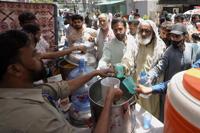ISLAMABAD (AP) ÔÇö Doctors treated hundreds of victims of heatstroke at hospitals across Pakistan on Thursday after an intense heat wave sent temperatures above normal levels due to climate change, officials said.
Temperatures soared as high as 49 degrees Celsius (120 degrees Fahrenheit) the previous day in Mohenjo Daro. The city, known for its archaeological sites, is in southern Sindh province, which was badly hit by climate-induced monsoon rains and devastating floods in 2022. The heat wave is forecast to continue for at least a week.
Authorities have urged people to stay indoors, hydrate and avoid unnecessary travel. But laborers say they don't have a choice because they need to work to feed their families.
ÔÇťPakistan is the fifth most vulnerable country to the impact of climate change. We have witnessed above normal rains, floods,ÔÇŁ Rubina Khursheed Alam, the prime ministerÔÇÖs coordinator on climate, said at a news conference in the capital, Islamabad.
Barakullah Khan, a civil defense official, asked people not to place cooking gas cylinders in open areas as a safety measure. He warned those living near fields that snakes and scorpions could enter homes and storage places in search of cooler spaces.
This month, temperatures are likely to soar to 55 C (131 F), weather forecasters said.
Doctors say they treated hundreds of patients in the eastern city of Lahore, while scores of people were brought to hospitals in Hyderabad, Larkana and Jacobabad districts in the southern Sindh province.
ÔÇťThe situation has been getting worse since yesterday, when people affected by heat started coming to hospitals in the Punjab province,ÔÇŁ said Ghulam Farid, a senior health official. Pakistan has set up emergency response centers at hospitals to treat patients affected by the heat.
The state-run ambulance service is now carrying bottled water and ice to provide emergency treatment to victims of the heat, health officials said.
The United Nations childrenÔÇÖs agency appealed for children to be protected from the heat.
ÔÇťUNICEF is deeply concerned about the health and safety of babies and young children as debilitating heatwave conditions take hold in several countries,ÔÇŁ said Sanjay Wijesekera, UNICEF regional director for South Asia. He said the increasing temperatures across the region could put millions of childrenÔÇÖs health at risk if they are not protected and hydrated.
Heatstroke is a serious illness that occurs when oneÔÇÖs body temperature rises too quickly, causing some to fall unconscious. Severe heatstroke can cause disability or death.
This year, Pakistan recorded its wettest April since 1961, with more than double the usual monthly rainfall. Last monthÔÇÖs heavy rains killed .
Daytime temperatures are soaring as much as 8 degrees Celsius (46 degrees Fahrenheit) above MayÔÇÖs average temperatures over the last 20 years, raising fears of flooding in the northwest because of glacial melting.
The 2022 floods caused extensive damage in Sindh and Baluchistan provinces, as 1,739 people were killed across the country.
Pakistan's southwest and northwestern areas are also experiencing the heatwave.
Authorities have shut schools for a week in Punjab.
On Thursday, nongovernmental organization Save the Children said more than half of PakistanÔÇÖs school-age children ÔÇö about 26 million ÔÇö will be locked out of classrooms for a week due to the heat wave. In a statement, it said the closure of the schools in Punjab means 52% of the countryÔÇÖs students will be out of school.
In the city of Lahore people were seen swimming in roadside canals. Pakistan says despite contributing less than 1% to carbon emissions, it is bearing the brunt of global climate disasters.
Alam said recent erratic changes in weather patterns were the result of human-made climate change.
___
Associated Press writer Babar Dogar contributed to this story from Lahore, Pakistan.
___
Follow APÔÇÖs climate and environment coverage at












































